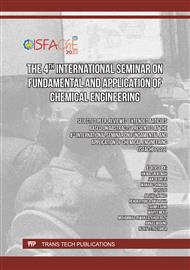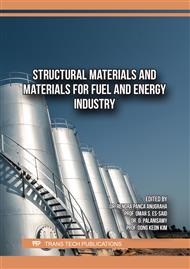[1]
Directorate General of Estate Crops, Statistical of National Leading Estate Crops Commodity 2019-2021, Ministry of Agriculture, Jakarta, 2020.
Google Scholar
[2]
Toiby, A. rahman, Rahmadani, E., & Oksana, Changes in Chemical Properties of Palm Oil Empty Fruit Bunches Fermented With Em4 At Different Doses And Ripening Time. Journal of Agrotechnology, 2016, 6(1), 1–8.
Google Scholar
[3]
Pramana, A., Cahyanto, M. N., Adhianata, H., & Zalfiatri, Y., Physical Characteristics of Lignin in Oil Palm Empty Fruit Bunches Fiber PT. Tunggal Perkasa Plantataions Riau Province Using the Organosolv Method, Journal of Environmental Pollution Control, 2020, 2(1), 43–49.
DOI: 10.35970/jppl.v2i1.153
Google Scholar
[4]
Fatriasari, W., Masruchin, N., & Euis, Cellulose: Characteristics and Utilization, 2019.
Google Scholar
[5]
Hidayat, M. R., Pretreatment Technology of Lignocellulose Materials in Bioethanol Production Process, Industrial Biopropal, 2013, 4(1), 33–48.
Google Scholar
[6]
Ma'ruf, A., Pramudono, B., Aryanti, N., Lignin Isolation Process from Rice Husk by Alkaline Hydrogen Peroxide: Lignin and Silica Extracted, International Conference on Chemistry, Chemical Process and Engineering (IC3PE), 2017.
DOI: 10.1063/1.4978086
Google Scholar
[7]
Miller, G. L. (1959). Use of Dinitrosalicylic Acid Reagent for Determination of Reducing Sugar. Analytical Chemistry, 31(3), 426–428.
DOI: 10.1021/ac60147a030
Google Scholar
[8]
Achmadi, S.S, Wood Chemistry, Inter-University Center for Biotechnology, Institut Pertanian Bogor, 1990.
Google Scholar
[9]
Arif, A. R., Erviani, A. E., Natsir, H., Haidir, I., & Affandy, M. A., Optimization of Pretreatment through Hydrothermal Pressure Method and Alkaline Solvent on Bioethanol Production from Lemna minor, Alchemy Journal of Chemical Research, 2018, 14(1), 95.
DOI: 10.20961/alchemy.14.1.15986.95-106
Google Scholar
[10]
Aiman, S., Effect of Particle Size of Lignocellulosic Biomass on Bioethanol and Biobutanol Production: Overview, Indonesian Journal of Applied Chemistry, 2016, 18(1), 11–25.
Google Scholar
[11]
Sindhuwati, C., Mustain, A., Octaliya Rosly, Y., Soharmat Aprijaya, A., Sonya Suryandari, A., & Rulianah, S., Review: Potential of Oil Palm Empty Fruit Bunches as Raw Material for Bioethanol Production with the Fed-Batch Method in the Hydrolysis Process, Journal of Chemical and Environmental Engineering, 2021, 5(2), 128–144.
DOI: 10.33795/jtkl.v5i2.224
Google Scholar
[12]
Juliastuti, S. R., Hendrianie, N., Sabar, K. R., & Anggita, S., Glucose Production from Oil Palm Empty Fruit Bunch (OPEFB) using Microwave and Fungal Treatment Method, IOP Conference Series: Earth and Environmental Science, 2022, 963(1).
DOI: 10.1088/1755-1315/963/1/012053
Google Scholar
[13]
Robitoh, M. F., Combination of Microwave Irradiation and Extractive Fermentation for Optimization of Bioethanol Production from Rice Straw, National Seminar on Chemistry "The Role of Chemistry in the Development of an Environmentally Friendly Chemical Industry", 2015, ISSN 2338-2368, May.
Google Scholar
[14]
Heerah, A. S., Mudhoo, A., Mohee, R., & Sharma, S. K., Steam Pre-Treatment of Lignocellulosic Wastes for Biomethanogenesis: A Preliminary Study, Rasayan Journal of Chemistry, 2008, 1(3), 503–514.
Google Scholar
[15]
Ye, J., Lan, J., Xia, Y., Yang, Y., Zhu, H., & Huang, K., An Approach for Simulating the Microwave Heating Process with a Slow- Rotating Sample and a Fast-Rotating Mode Stirrer, International Journal of Heat and Mass Transfer, 2019, 140, 440–452.
DOI: 10.1016/j.ijheatmasstransfer.2019.06.017
Google Scholar
[16]
Maharani, D. M., & Rosyidin, K., The Effect of Microwave-NaOH Pretreatment on Kepok's Petiole Flour to The Cellulose Yield, Agritech, 2018, 38(2), 133–139.
DOI: 10.22146/agritech.16657
Google Scholar
[17]
Heitz, M., Capek-Ménard, E., Koeberle, P. G., Gagné, J., Chornet, E., Overend, R. P., Taylor, J. D., & Yu, E., Fractionation of Populus tremuloides at The Pilot Plant Scale: Optimization of Steam Pretreatment Conditions using The STAKE II Technology. Bioresource Technology, 1991, 35(1), 23–32.
DOI: 10.1016/0960-8524(91)90078-x
Google Scholar
[18]
Muryanto, M., Sudiyani, Y., & Abimanyu, H., Optimization of the NaOH Pretreatment Process of Oil Palm Empty Fruit Bunches to become Bioethanol, Indonesian Journal of Applied Chemistry, 2016, 18(01), 27–35.
DOI: 10.1016/j.egypro.2015.03.242
Google Scholar
[19]
Permatasari, H., Gulo, F., & Lesmini, B., The Effect of H2SO4 and NaOH Concentration on Bamboo Powder Delignification (Gigantochloa apus), Journal of Chemical Education Research: Study of Chemical Education Research Results, 2014, 1(2), 131–140.
Google Scholar
[20]
Susanti, E., Ayu, T., & Damayanti, W., Lignocellulolytic Profile of Phanerochaete chrysosporium on Various Carbon Sources, Proceedings of the National Seminar on Chemistry and Learning, 2018, 148–154.
Google Scholar
[21]
Hendrianie, N., & Juliastuti, R., The Role of Phanerochaete chrysosporium Fungi in Bagasse and Oil Palm Empty Fruit Bunches Pretreatment Process for Renewable Energy Source, Purification Journal, 2009, 10(2), 133–140.
Google Scholar
[22]
Sutari, N. W. S., Isolation and Morphological Identification of Cellulolytic Fungus from Household Waste in Sanur Kauh Village, Bali, Agrovigor: Journal of Agroecotechnology, 2020, 13(2), 100–105.
DOI: 10.21107/agrovigor.v13i2.7443
Google Scholar



